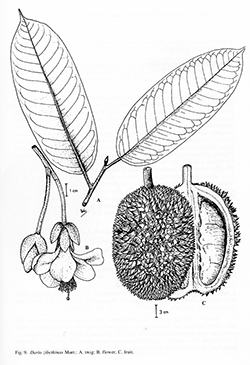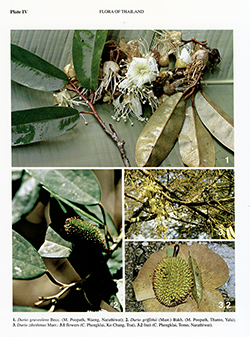e-Flora of Thailand
Volume 9 > Part 1 > Year 2005 > Page 26 > Bombaceae > Durio
5. Durio zibethinus Murr.
Syst. Nat. Veg.: 581. 1774; Mast. in Hook.f., Fl. Brit. Ind. 1: 351. 1874; Kurz, Forest Fl. Burma 1: 132. 1877; Brandis, Ind. Trees: 78. 1907; Gagnep. in Lecomte, Fl. Indo-Chine 1: 454. 1911; Ridl., Fl. Malay Penins. 1: 261. 1922; Bakh., Bull. Jard. Bot. Buitenzorg S. 3. 6: 229. 1924; Wyatt-Smith, Kew Bull. 530. 1953; Kosterm., Reinwardtia 4 (3): 72. 1958. Fig. 9; Plate IV: C–D.
Accepted Name : This is currently accepted.
Description : Semi-evergreen tree, up to 25 m high; bark rough, peeling off irregularly, grey or reddish; sapwood reddish, heartwood reddish-brown. Twigs slender, covered by yellow scales; young buds reflexed. Leaves elliptic, elliptic-oblong to oblong, 10–20 by 3–7 cm; apex acuminate; base obtuse; margin entire; chartaceous to sub-coriaceous, upper surface glabrous, lower surface densely covered by minute, silvery or gold-like scales; secondary nerves in 9–14 pairs, anastomosing, reticulate veins slightly distinct on upper surface. Petioles 1–2 cm swollen at top, covered by scales. Inflorescences 3–30-flowered corymb, on old branches; buds ovoid, ca 2 cm in diam.; all covered by yellow scales; pedicel 5–6 cm long, thickened towards the apex. Epicalyx ovate, with 2–3 concave erect lobes, ca 1.5 cm long, caducous, outer part with brown scales, inner part with stellate hairs. Calyx urceolate or tubular, ca 2 cm long, yellow scales outside, glabrous except near base inside. Petals white, spathulate, erect, ca 4 by 1–1.2 cm, sparsely hairy outside, glabrous inside. Stamens numerous, devided into 5 group, each group free; anthers reniform, dehiscing by a slit. Ovary ovoid, 5–7 by 3–4 mm, covered with yellow scales, 5-locular, locule with 2–4 ovules; style pilose and scaly, minutely protruding beyond the stamens, stigma capitellate. Fruit ovoid to ellipsoid, 20–30 by 18–25 cm, with sharply pointed, pyramidal spines; indehiscent. Seeds 2–3 in each valve; aril yellowish or white, completely covering the seed.
Thailand : Cultivated in the Northern, Central, South-Eastern and Peninsular regions.
Distribution : Cultivated throughout SE Asia. Perhaps wild in Sumatra and Borneo (type not mentioned).
Ecology : Cultivated at low altitudes, from sea level up to 300 m. No report of fruit above an altitude of 1,000 m.
Vernacular : Thurian (ทุเรียน); rian (เรียน)(Peninsular).
Uses: The durian is one of the most highly esteemed fruits in Thailand; not only in the edible aril, but seeds are also edible when cooked. Wood is used for indoor construction and furniture.
E-version notes : As Durio zibethinus L., J.A.Murray (ed.), Syst. Veg. ed. 13: 581 (1774)


